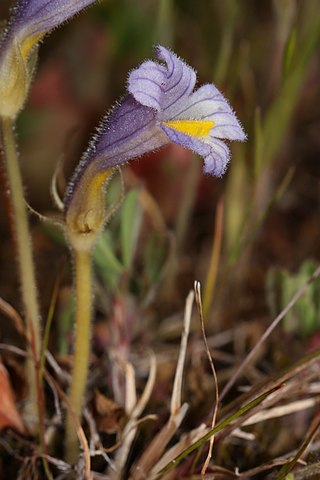
Orobanche, commonly known as broomrape, is a genus of almost 200 species of small parasitic herbaceous plants, mostly native to the temperate Northern Hemisphere. It is the type genus of the broomrape family Orobanchaceae.

A parasitic plant is a plant that derives some or all of its nutritional requirements from another living plant. They make up about 1% of angiosperms and are found in almost every biome. All parasitic plants develop a specialized organ called the haustorium, which penetrates the host plant, connecting them to the host vasculature – either the xylem, phloem, or both. For example, plants like Striga or Rhinanthus connect only to the xylem, via xylem bridges (xylem-feeding). Alternately, plants like Cuscuta and some members of Orobanche connect to both the xylem and phloem of the host. This provides them with the ability to extract resources from the host. These resources can include water, nitrogen, carbon and/or sugars. Parasitic plants are classified depending on the location where the parasitic plant latches onto the host, the amount of nutrients it requires, and their photosynthetic capability. Some parasitic plants can locate their host plants by detecting volatile chemicals in the air or soil given off by host shoots or roots, respectively. About 4,500 species of parasitic plants in approximately 20 families of flowering plants are known.
NVC community CG2 is one of the calcicolous grassland communities in the British National Vegetation Classification system. It is one of three short-sward communities associated with heavy grazing, within the lowland calcicolous grassland group, and is regarded as "typical" chalk grassland.
Typical flora of Malta consist of the following plants. While small compared to other countries, the Maltese Islands contain flowers that grow on Malta, Gozo, Comino, Filfla, St Paul's Islands and Fungus Rock. Many of the species are endemic to Malta.

Orobanche uniflora, commonly known as one-flowered broomrape, one-flowered cancer root, ghost pipe or naked broomrape, is an annual parasitic herbaceous plant. It is native to much of North America, where it is a parasitic plant, tapping nutrients from many other species of plants, including those in the families Asteraceae and Saxifragaceae and in the genus Sedum. The name "orobanche" can be translated to "vetch-strangler" and "uniflora" can be translated to "single-flower".

Orobanche rapum-genistae, the greater broomrape, is a plant species in the genus Orobanche. It is a parasitic plant, native to Europe, growing on the roots of plants in the bean family, usually common broom or European gorse.

Orobanche crenata is a species of broomrape, commonly known as bean broomrape. It is a common parasite of the faba bean, Vicia faba. It is native to the Mediterranean basin in Europe and North Africa, the Arabian Peninsula, and Western Asia through to Iran. It has been introduced elsewhere, including Ethiopia. It has no chlorophyll, and gets its carbohydrates from the host's phloem, and water and minerals from the host's xylem. It is a constant threat to legume production.

Limodorum is a genus of myco-heterotrophic orchids. All species are temperate terrestrial plants and occur across much of Europe, North-West Africa, the Mediterranean Islands, and as far east as Iran. Plants have evolved away from photosynthesis and as a result their leaves are reduced to scales. There is still chlorophyll present but the plants are believed to be solely dependent on their fungal partner for nutrients. They spend most of their life underground as a short stem with fleshy roots, the unbranched inflorescence can appear in April to June if conditions are favourable.
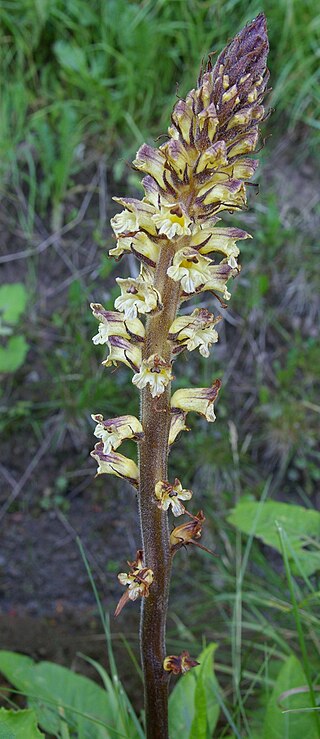
Orobanche reticulata is a species of broomrape known by the common name thistle broomrape. It is a parasitic plant whose host is normally the creeping thistle. It is native to the lowlands of Western Europe and Central Asia, but in the United Kingdom it is a rare and protected plant, growing only in Yorkshire, on grassland sites such as Quarry Moor.
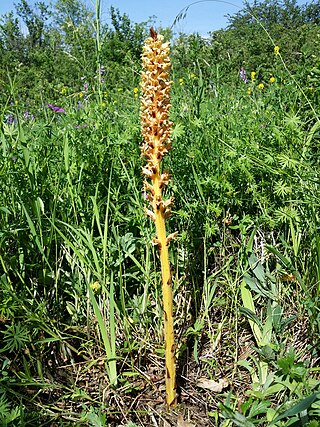
Orobanche elatior the knapweed broomrape is a species of flowering plant belonging to the family Orobanchaceae.
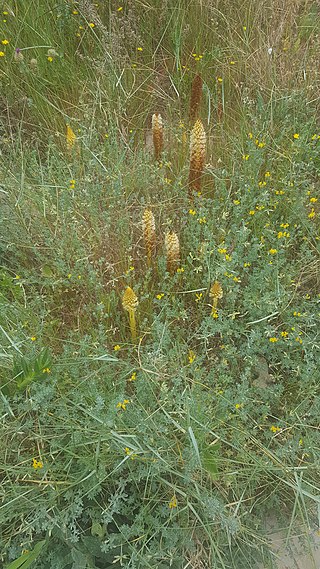
Orobanche densiflora is a species of plant in the family Orobanchaceae. O. densiflora f. melitensis was reputed to be endemic to Malta however such information is not corroborated by recent accounts.
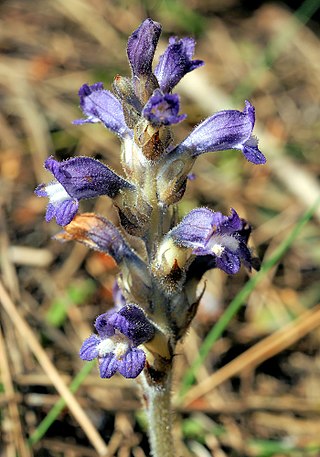
Orobanche mutelii, the dwarf broomrape, is a species of plant in family Orobanchaceae. It is endemic to Malta.
Orobanche canescens is a species of herb in the family Orobanchaceae. Individuals can grow to 0.4 m.

Orobanche caryophyllacea is a species of plant in the family Orobanchaceae.
Orobanche cernua, commonly known as nodding broomrape, is a species of herb in the family Orobanchaceae. They have a self-supporting growth form and simple, broad leaves. Individuals can grow to 0.4 m. Holoparasite of Artemisia spp. Distribution: Europe, SW Asia, Russia, Kazakhstan, Turkmenistan,
Orobanche clausonis is a species of plant in the family Orobanchaceae.

Orobanche lavandulacea is a species of plant in the family Orobanchaceae.

Orobanche pubescens is a species of annual herb in the family Orobanchaceae. They have a self-supporting growth form. Individuals can grow to 0.17 m.
Orobanche sanguinea is a species of herb in the family Orobanchaceae. Individuals can grow to 0.17 m.

Orobanche alba, also known by its common names thyme broomrape and red broomrape, is a holoparasitic plant of the broomrape family. It parasitises plants from the mint family.














